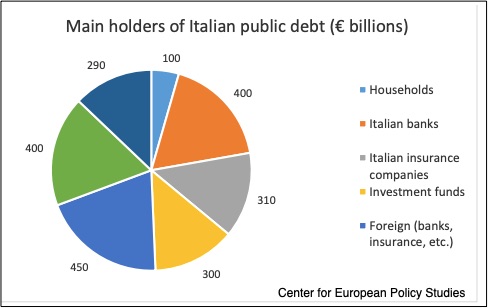
The Pricey Purse That Created a Problem
March 3, 2020
Why Do the Rich Believe They Became Rich?
March 5, 2020Just six months ago, Italy’s economic news was not so good. The government was even selling palazzos to nibble down a gargantuan national debt.
Six Facts About the Italian Economy
1. Economic growth, if at all, has been sluggish.
Now, with the impact of the coronavirus outbreak, Italy could have a tough time offsetting its economic impact.
Too many years were a growth minus:
2. Compared to its neighbors, Italy has one of the lowest GDP growth rates.
One economist explained that Italy’s biggest problem was its dependence on medium-sized businesses. They can excel with production but not innovation, they have difficulty competing globally.
On the following output graph, in 2007, Germany, France, Spain, and Italy were bunched together. After that, Italy fell increasingly behind:
3. Correspondingly, unemployment remains high.
You can see that it’s been awhile since Italy’s unemployment rate was close to the U.S. 3.6 percent rate. Nearly 43 percent in 2014, Italy’s youth unemployment now is approximately 29 percent.
After the great recession (end of 2007 to mid 2009), Italy’s jobless numbers soared, then improved, but still are elevated.
4. Meanwhile, and perhaps most concerning, Italy’s debt is massive.
Italy has a debt equal to 130% of its GDP. At 180%, only Greece is in worse shape. But because Italy will need additional coronavirus spending, what its owes could limit how much more it borrows.
You can see that many different groups of people have loaned Italy money by purchasing its bonds:
5. Italy’s economic engine is at the vortex of its coronavirus outbreak.
While the following map displays Italy’s GDP leader, it also reflects where the coronavirus is concentrated. Emblematic of the GDP impact, Italy had to ban all flights to and from China, a $16 billion buyer of its exports. Most of China’s clothing editors and buyers and buyers were unable to attend Milan’s fashion week.
Yesterday, far exceeding other regions in Italy, Lombardy’s coronavirus cases totaled 1524:
6. Especially in Northern Italy, factories, stores, tourism, and households have been monumentally constrained by the coronavirus outbreak.
In areas of Northern Italy, schools and universities have shut down. People are working from home, many bars, restaurants and theaters (including Milan’s La Scala) are closed. At the same time, church services have been cancelled, funerals limited to relatives, and areas south of Milan are quarantined. As for tourism, according to Milan’s hotel association president, in just five days, somewhere between 50 to 80% of all hotel reservations have been cancelled.
Better than a map or a graph, this empty tram in Milan shows the economic impact of the coronavirus:
Our Bottom Line: Fiscal Policy
As one of the hardest hit countries, Italy’s fiscal policy is responding to the coronavirus outbreak:
Fiscal policy includes a country’s spending, taxation, and borrowing decisions. Now, with its coronavirus crisis, the Italian government says it will be spending an extra €3.6 billion ($4 billion).
Looking back at #4, I wonder how Italy’s debt will affect coronavirus spending.
My sources and more: Always handy for some solid but bland facts, WEF was a good place to start. Next, and much more interesting, The Washington Post and The Local had up-to-date facts about the Italian economy as did FT and Bloomberg. And finally, I did find a helpful CEPS primer on Italian debt.
![econlifelogotrademarkedwebsitelogo[1]](/wp-content/uploads/2024/05/econlifelogotrademarkedwebsitelogo1.png#100878)











